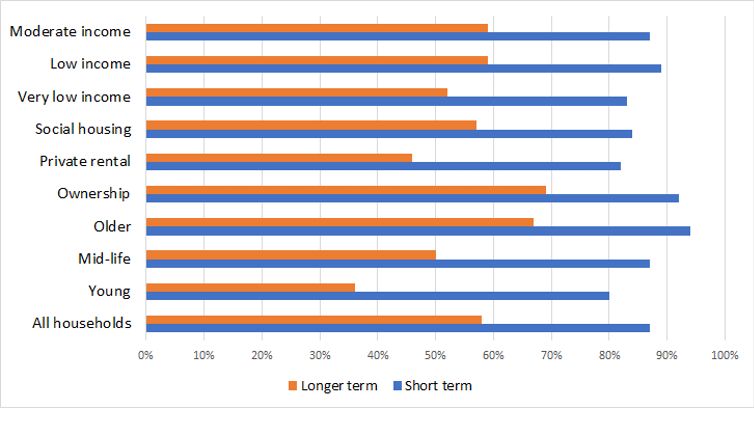How might COVID-19 change what Australians want from their homes?

Survey results inform researchers about short and long-term housing needs | Shutterstock
In summary
Analysis for The Conversation by Associate Professor Wendy Stone, Director of the Australian Housing and Urban Research Institute Swinburne Research Centre, Swinburne University of Technology; Professor Amity James, Senior Lecturer, Curtin University; Dr Sharon Parkison, Senior Research Fellow, Swinburne University of Technology; Dr Steven Rowley, Director of the Australian Urban and Research Institute, Curtin University.
New research released today asked Australians how well current housing met their needs and their ideals, both in the short and longer-term.
We found safety and security was the main aspiration of householders across age groups. Given the turbulent year for many households, we wished to explore how the pandemic might change what people want from their homes.
What do people want from a home?
We surveyed more than 7,400 Australians in young, mid-life and older households, including Indigenous, non-Indigenous and widely diverse Australians, online or in interviews.
We asked what they want from housing, and the constraints that mean they haven’t been able to get there.
We found “safety and security” were fundamental to the housing aspirations of young, mid- and later life Australians. Some 75% of respondents indicated these basic characteristics were the key housing attributes they value. For a majority of Australians, these attributes were associated with home ownership.
The figure below shows four in five Australians are satisfied with their current housing in the short term, but when they consider their longer term needs these levels of satisfaction drop considerably. This is particularly so among renters, linked to a lack of security in the tenure.

How well current housing meets longer-term housing aspirations. Original analysis of Australian Housing Aspirations Survey (2018) data, unweighted
The survey asked participants to choose their ideal housing in terms of location, tenure, dwelling type and number of bedrooms. The results showed there was a preference for owning a house with three or more bedrooms within the suburbs of capital cities, with a notable number also showing a preference for regional living.
But not all households believe they can attain this ideal with rising inequality also fuelling the housing aspirations gap. When we asked households what they need to achieve their ideal housing, results show targeted support is critical — such as assistance with up-front deposits, fees or bonds, and support to manage ongoing housing costs in the context of disruptions such as COVID.
What about post-COVID?
If anything, the pandemic has reinforced trends in housing aspirations.
First, housing security matters. The disruptions of 2020 have highlighted housing insecurity, particularly among those with precarious incomes. Government interventions including JobKeeper, JobSeeker, evictions moratoria and schemes such as the Victorian Rental Relief Grant have been necessary to keep renters in their homes, with banks having deferred mortgage payments for tens of thousands of additional households.
Second, walkable neighbourhoods are the way of the future. COVID-19 reaffirms the importance of local neighbourhoods as amenity centres. This includes local areas that include green space, local produce and a sense of community. Our findings show suburban living and regional towns are attractive options for households across all ages, including younger adults.
Third, adaptable living is key. Home has never been as important as a hub of both productivity and care. Working from home and online education have become the norm for many households in Australia and globally. This requires adequate space, quality digital connectivity and adaptable living areas that can accommodate the whole family and different activities.
Young adults have needed to relocate quickly in some cases, with households at mid-life finding themselves potentially housing both young adult children (and maybe grandchildren) as well as elderly parents. As fears rise about the safety of existing aged care residences, housing that supports home-based elder care also becomes critical.
Creating a better housing future
Our research shows safety and security is key to what people want from housing, so reducing entry costs to home ownership and delivering rent-buy models (that enable people to transition from renting to buying) are important policy directions.
Improving housing knowledge and housing market skills to enable households to explore options, make more informed housing decisions and plan for their housing futures are also key elements. Creating optimal housing requires collaborating with residents as experts, on what they value.
This article is republished from The Conversation under a Creative Commons license. Read the original article.
-
Media Enquiries
Related articles
-

- Social Affairs
Swinburne is committed to reconciliation “Now More Than Ever”
Swinburne held events across our three campuses to mark National Sorry Day and National Reconciliation Week.
Friday 31 May 2024 -

- Social Affairs
Landmark Swinburne study exposes ongoing discrimination and homophobia
More than half of LGBTIQA+ young people in Australia have witnessed discrimination in community-based sport, according to a new Swinburne University of Technology study.
Friday 17 May 2024 -

- Social Affairs
Too many renters swelter through summer. Efficient cooling should be the law for rental homes
Summer is coming – and it’s starting earlier, becoming hotter and lasting longer. As the hot weather hits, many renters will be sweltering in their homes. The World Health Organization recommends a list of actions for people to deal with heat. At the top of the list is “keep your home cool”. But for many renters, this isn’t possible.
Wednesday 22 November 2023 -

- University
- Social Affairs
In 5 years, this Australian astrophysics lab reached 50% women. Here’s how they did it
Many organisations, from community sporting groups to the United Nations, have set themselves a target of gender parity: ensuring half of staff or members are women. Gender parity is desirable because training and retaining equal halves of a population’s available talent influences an organisation’s growth, problem-solving capacity and future-readiness.
Friday 17 November 2023 -

- Social Affairs
Swinburne students win third consecutive Advertising Capstone Challenge
Four Swinburne students have designed a winning campaign for BONDS Bloody Comfy Period Undies.
Friday 10 November 2023

